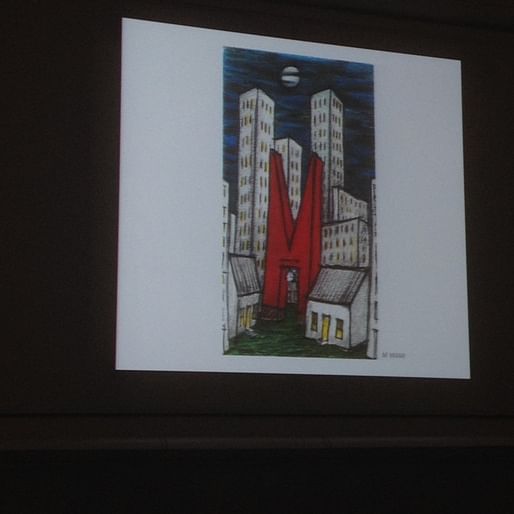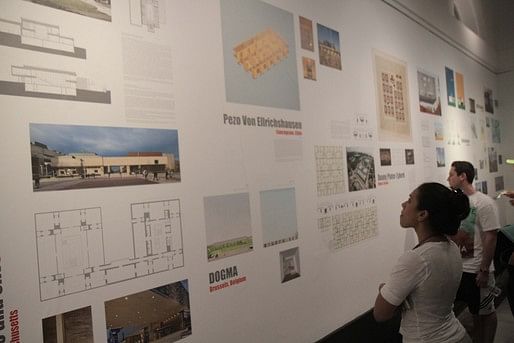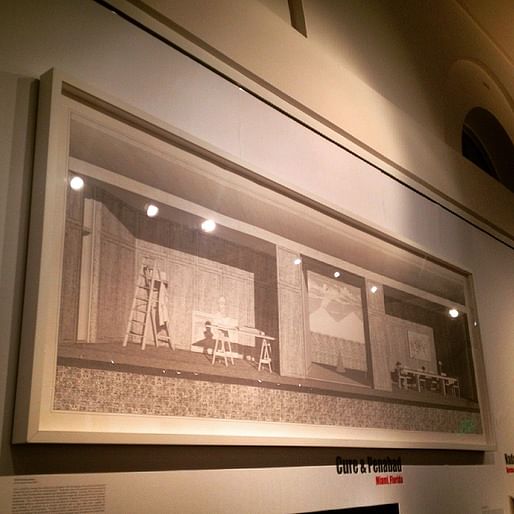

The Tecnoglass Lecture Series, “Call to Order”, continued this Wednesday with a presentation by local Miami architecture firm R & R Studio. The studio is helmed by husband and wife team Roberto Behar and Rosario Marquardt, and operates a small but influential practice near Miami’s Design District. Behar is the only presenter from the series who is also a member of the faculty at the University Of Miami School Of Architecture. A popular professor, he gave a lecture to crowded audience of faculty, students, and alumni who returned to the school for the event. The lecture was followed by the opening of the Call to Order Gallery Exhibit.

Behar’s lecture, entitled Building Stories, is a review of the office’s work and its connection to art, public space, history, site, scale, and freedom. A majority of the work represents itself in a style of magical realism, a concept that may have subconsciously evolved from the duo’s upbringing in Latin America. The first project of the evening known as “M” invokes the notion that it is more than it seems. The solitary M can be a landmark due to its proportions and location, but could also be seen as an urban toy of the city due to its color and playful shape. The M can also be seen, as Behar states, as unfinished similar to its downtown surroundings. Also, what could the M stand for: Miami? Mother? Monument(al)? Marvelous? It is for the viewer to decide.

Similar to this project is his famous Living Room. Behar remarks that he and his wife were approached by a developer to do something that brings attention to an unremarkable corner with a limited budget. The building offered no public definition to the block, and no protection to the elements. The designers essentially carve out the existing corner and extend the remaining perimeter walls higher. Adding a roof for shade, the space was turned into a real living room complete with couch, window, and furniture for an urban city scale. The designers even create a custom wallpaper pattern; this trademark of detailing can be found in much of their work. Thus the bland corner building is given a major overhaul, and becomes an actual room for the neighborhood.

Other projects like their façade proposal for the Museum of Art in Ft. Lauderdale and Cruaute Et Utopia in Brussels present two different ways to deal with urbanism. The first gives prominence to the entry of the museum which neglects the park in front of it and river beyond. The architects propose a “super front porch”, complete with geometric inspired columns and a colorful covered terrace reminiscent of the pastels found in the Caribbean and Central America. The “Super Front Porch” then orients itself to the park to serve as a nexus for public space. The project in Belgium does quite the opposite and hides the façade to break up the continuation of the brick veneers on the street. Using a playful screen of multicolor ribbons, the sense of mystery is created as well as wonder, leaving the visitor to feel transported once crossing its threshold. Behar equates to this addition as a mask, where a temporary identity is provided to the building, recalling the purpose of masks used in Venice carnivals. “Masks allow us to be someone else”, he states. Why couldn’t it do the same for a building?

In a question and answer session that followed the lecture, Behar and Marquardt are asked how do they escape the idea of being kitsch; their work is contemporary and modern, but modernism has a history of rejecting ideas that the couple employ frequently like color. They respond that their work is driven by taste, but more importantly, by reminiscing of their time as children. They are influenced by this way of thinking because when we are young, we do not worry or fear. Every day holds marvel, curiosity, and more so, the idea that anything is possible. When we are young we are believe in spirit of magic, and are seduced by poetics. Their work embodies those characteristics.

The final project supports this theory; a simple proposal to enhance the Miami skyline with the letters “I LOVE YOU” on top of three skyscrapers. The words could have multiple meanings as Behar remarks: Is it the city telling us that it loves us? Could it be the citizen stating that emotion to Miami? Are the words asking visitors and travelers to stay a little bit longer? Behar and Marquardt conclude by saying that “our architecture is not a platform to frame an answer, our purpose and interests are to provide platforms for questions.”
-----------------------------------------------------------------------------
The work on display for the Call to Order Exhibition contains the work of the following firms(in no particular order):
-Arquitectonica
-Machado and Silvetti Associates
-Cure & Penabad
-Productora
-Dogama
-NADAAA
-2A+P/A
-Johnston Marklee
-Pezo Von Ellrichshausen
-R&R Studios
-Damiani NGO Phiffer
-DLGV Architects and Urbanists
-Salottobuono
-Aldo Rossi
The exhibit will be open from April 8th and run through the Summer. 


This blog gives a sneak peak into the architecture world at the University of Miami. What began as an experiment following one group of incoming graduate students through their first semester of design, has morphed into a window of the school of architecture through this professor's eyes. I will try to post as often as possible.
No Comments
Block this user
Are you sure you want to block this user and hide all related comments throughout the site?
Archinect
This is your first comment on Archinect. Your comment will be visible once approved.